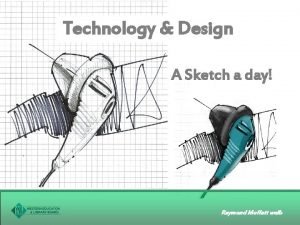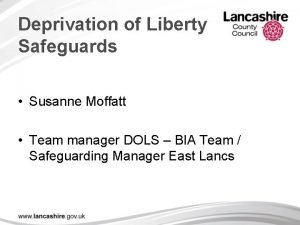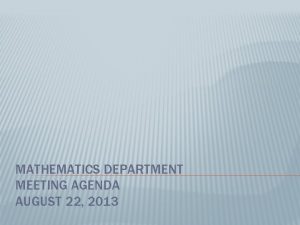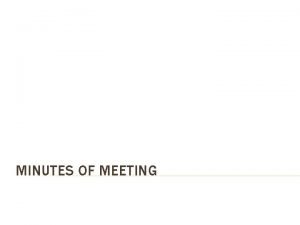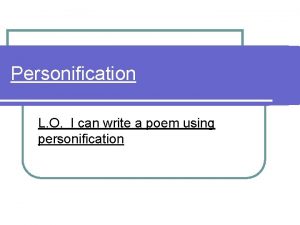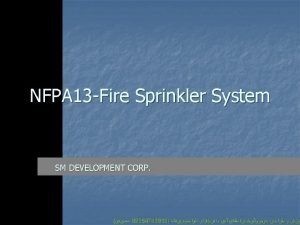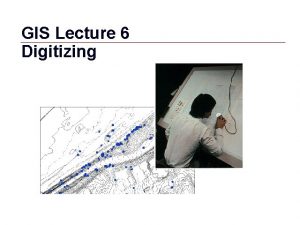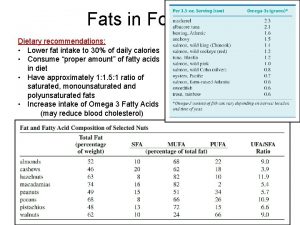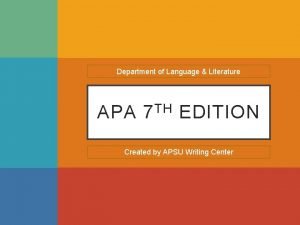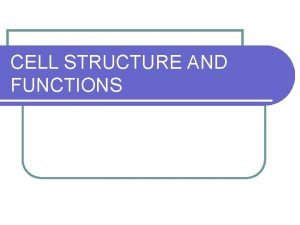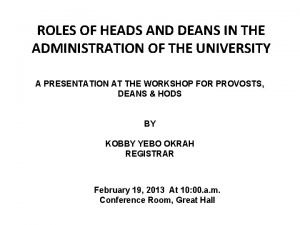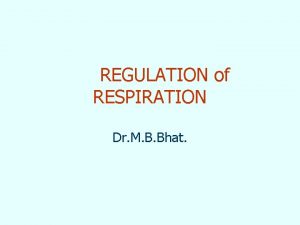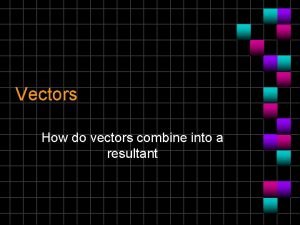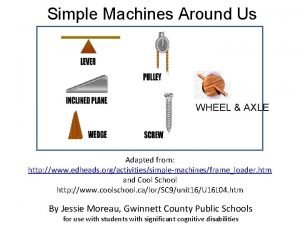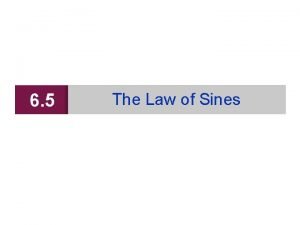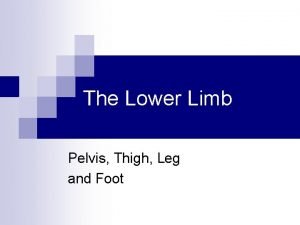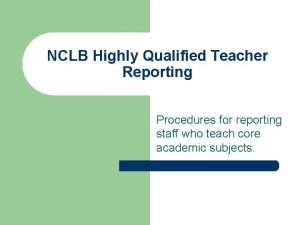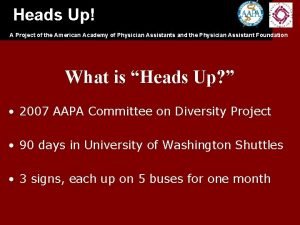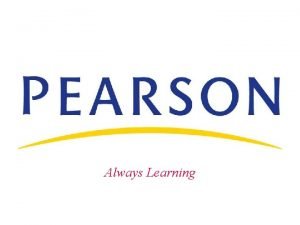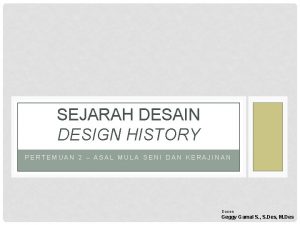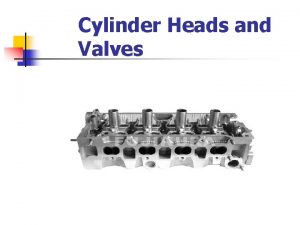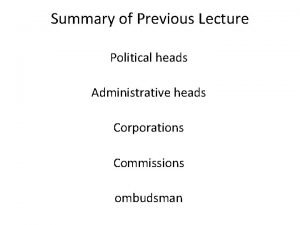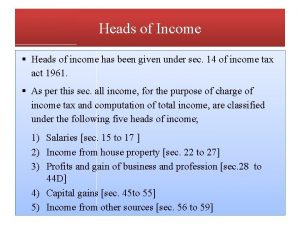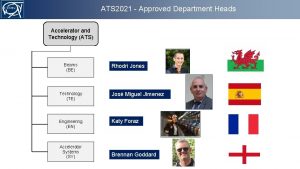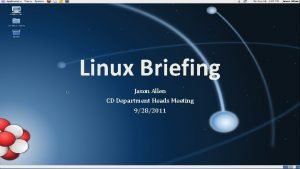Technology Design Heads of Department Meeting RA Moffatt
















































- Slides: 48

Technology & Design Heads of Department Meeting RA Moffatt.

Aims To provide an update on the CEA curriculum proposals in respect of issues which will impact on T&D departments. To examine the role of the HOD in the management of H&S within the department. To provide a brief overview of current H&S legislation relating to primary T&D. Provide an update on new resources which will assist in H&S management in T&D. To consider DE plans for Self Evaluation as an improvement strategy in schools. To discuss recent developments in ICT relating to T&D.

Key ideas in CCEA review KS 3 Pressures for change Transferable skills and capabilities, need for team players, problem solvers and decision makers (employers ) Local and Global Citizenship ( new legislation inc. WELB Agreement ) Greater relevance, motivation, reasons for content ( young people ) Wider choice, greater flexibility, less content, reduction in terminal assessment workload ( teachers ) Other background factors: - Burns Proposals, Costello report

Key ideas in CCEA review KS 3 New curriculum aims and objectives: • Reduced content • Greater emphasis on transferable skills • Greater emphasis on PSHE • Employability Schools will be given more choice to: “ …create a more coherent, enjoyable, motivating and relevant curriculum. ” How ? • Common minimum entitlement for all • Prepare pupils with new skills for the world of work and life beyond school

Key ideas in CCEA review KS 3 Skills areas Creativity Managing information Problem solving Decision making Working with others Communication Application of number Use of ICT T&D is well placed to contribute to all of these areas

Key ideas in CCEA review KS 3 Structure Learning for life and work – Employability – Local and global citizenship – Personal development ( PSHE and HE ) General learning areas – – – – The arts ( Art & Design and Music ) English and Irish ( Media & Drama ) Environment and society Modern languages Math's PE Science & Technology RE

Key ideas in CCEA review KS 3 Assessment proposals • • Remove KS tests in Math's English & Science at 14 Uniform system of reporting for all schools Greater emphasis on formative assessment Annual, standardized, ICT assisted reports on these areas: Learning for life and work…. Communication, Application of number, ICT General learning areas and subject strands Critical and creative thinking skills Personal and interpersonal skills Attitudes, aptitudes and interests

New curriculum jargon • • • Learning area ( Science & Technology ) Subject strand (Technology & Design ) Statement of entitlement ( see sheet ) Curriculum objectives 1, 2 & 3 ( see columns ) Key Elements (see sheet ) Learning outcomes (see sheet )

CCEA Feedback on T&D More agreement with the proposals for the more ‘ skills or process based subjects ’ where there was not such a body of knowledge that people wanted to see. The main trends coming out of the technology responses were that: Poor quality exemplars some of the examples seemed too contrived and all would not lead to a practical outcome. Time to include other curriculum objectives Other respondents were concerned that this seemed to be an expansion on what they were already expected to cover and therefore could not be done in the time that would be allocated to the subject. Wider contribution for T&D Teachers were glad to see that their subject could contribute fully to all of the curriculum objectives.

CCEA Feedback on technology. Amendments CEA have begun to do a bit of a tidy up job on the proposals. If you have any alternative/better suggestions CEA would be interested in getting them. Perhaps some better examples may come out of this meeting

Flexibility and discretion “ Teachers have considerable flexibility and discretion in deciding how to deliver this minimum entitlement, with the proviso that the contexts used help pupils to: relate learning to life and work; and help to meet the curriculum objectives, the key elements, skills and capabilities and learning outcomes. Teachers are expected to create learning opportunities beyond the minimum entitlement, depending on pupils’ interests and abilities, their own expertise and the resources and time made available in their schools. ”

Discussion point In your school, how do you think learning opportunities could best be created so that the minimum curriculum entitlement in T&D would be exceeded ? Identify the limiting factors that would be the strongest in respect of : a) pupils’ interests and abilities b) teacher expertise c) resources d) time resource sheets needed

How will it work out ? Interdisciplinary collaboration to make ‘connections in learning’ Models being suggested Co-ordination (same theme different strand ) Collaboration ( different strands working together ) Webbing ( use of common themes ) Integration ( dissolved subject boundaries ) New approaches to timetabling needed

Presentation 2 Health & Safety

Technology & Design Heads of Department Meeting

Current legislation includes • • • Health & Safety at Work Order NI 1978 Management of H&S at work regulations 1999 Health & Safety ( first aid ) regulations 1981 Personal protective equipment regulations 1992 The control of substances hazardous to health 1999 ( COSHH ) Manual handling operations regulations 1992 Electricity at work regulations 1989 Pressure systems and transportable gas containers regulations 1989 Provision and use of work equipment regulations 1992 Each of these regulations has associated codes of practice explaining how the regulations are to be interpreted e. g. BS 4163/2000

• Legislation and background • Duties of employers and employees • Policy to practice • ELB H&S policy • Hazards, risks and control measures • Risk assessment and management • Accidents • First Aid

Who is the employer ? Different employers for different schools Controlled schools Catholic Maintained ELB Catholic Council for Maintained Schools Integrated schools Governing Body Voluntary Schools Governing Body Irish Medium Schools Governing Body Independent schools Church / PLC/trust

Duty of employers • To care for the H&S of employees and others affected by their activities • The duty cannot be delegated but employers can delegate particular tasks to employees to enable them to meet their duties. ( HOD ) • The employer retains the responsibility for seeing that the task is done properly. ( CASS, H&S Officer )

Duty of employers • To ensure H&S in the place of work • Must give instructions on how this is to be achieved • Produce and implement a H&S policy statement ( H&S policy and directives, visits, audits )

Management of H&S Regulations • Identify hazards ( anything with the potential to cause harm ) • Assess risks ( legal requirement ) Risk likelihood severity • Provide training and retraining • Monitor H&S arrangements

Duty of employees • Take reasonable care for their own health & safety and that of others • To co-operate with their employer and not to misuse equipment provided for health & safety

• Legislation and background • Duties of employers and employees • Policy to practice • ELB H&S policy • Hazards, risks and control measures • Risk assessment and management • Accidents • First Aid

Policy Organising Planning Implementing Monitoring Auditing and reviewing

• Legislation and background • Duties of employers and employees • Policy to practice • ELB H&S policy • Hazards, risks and control measures • Risk assessment and management • Accidents • First Aid

Health and Safety ‘The WELB recognises and accepts responsibility for Safety and Health as an employer and in particular the duties laid down in article 4 ( employers duties) of the Health & Safety at Work Order NI 1978. ’ ‘ It also accepts the duties laid down in article 5 and 6 of that order to persons other than their employees’ note BCC ‘ The board will take all reasonably practicable steps to meet this responsibility for those employed by it in Catholic Maintained schools under the terms of article 88 of the Education and Libraries NI Order 1988. ’ ( BELB H&S Policy )

Health and Safety Responsibilities of the employer To provide: – a safe place of work, access and egress – a healthy working environment ( heat, light, sanitation) – safe arrangements for handling & storage of materials ( DE building guidelines ) – safe plant, equipment and systems of work (tenders) – sufficient information, instruction and training … to avoid hazards and contribute positively to employee safety. ( INSET for managers, teachers & technician training ) – adequate welfare facilities

Health and Safety Responsibility of the employer ‘Without detracting from the primary responsibility of Boards of Governors, Governing Bodies, Principals and Supervisors for ensuring safe conditions of work, the Board, where reasonably practicable, will provide competent technical advice on safety and health matters where this is necessary to assist management in its task. ’ ‘The arrangements outlined in the policy statement and the various provisions made by the Board, cannot in themselves prevent accidents or ensure safe and healthy working conditions. Only good working practices will ensure safety’

Health and Safety Responsibility of the HOD ( WELB Health and Safely Policy Statement ) Heads of Department are responsible for ensuring that the content of the Safety Policy is followed in practical terms in areas under their control. In the discharge of this responsibility each Head of Department shall : Prepare a departmental Safety Policy ( see handout for contents) Ensure that all teaching staff hold appropriate qualifications

Health and Safety Responsibility of the HOD ( WELB Health and Safely Policy Statement ) Ensure that all staff include safe working practices in their instruction to pupils and students. Ensure that any equipment or machinery known to need repair is not used until the necessary repair work has been carried out Report all accidents and potential hazards to the principal/appointed person Ensure that all protective clothing and equipment as required are available in the department. In the absence of the Head of Department, the Principal or a senior teacher nominated by the Principal will assume the responsibility. . Ensure that all significant risks within their area of responsibility are assessed and control measures implemented

Health and Safety Responsibility of the HOD ( WELB Health and Safely Policy Statement ) Ensure that both teaching and non-teaching staff are provided with regular training that will assist them to work safely Ensure that all Safety Reports pertaining to their department are fully Implemented Ensure that all safety instructions and advice issued by the board or the Department of Education are acted upon. ( BELB safety bulletins, DE circulars ) Ensure that all staff in the department are aware of any safety precautions to be put in place when undertaking potentially hazardous procedures Ensure that all toxic and flammable substances are correctly labelled, stored and used

Health and Safety DENI Safety Series No 10 (1991) Safety in School Workshops (Section 13) ‘…teachers proposing to use any of the following machines or processes should have undertaken specific training and hold appropriate qualifications in their use. ’ Heat Treatment Oxy-acetylene welding MIG welding (Sand casting) Woodworking Circular saw Band saw Additionally: PCB unit Horizontal grinder Wood lathe, pedestal drill and linisher Metalworking Milling machine Abrasive wheels Centre Lathe

Health and Safety DENI Circular 1999/8 Safety in School Workshops • Paragraph 2 Only one pupil at any one time should use a particular machine. • Paragraph 3 A foot operated cut-out switch should be fitted to all machines requiring the use of both hands. Above includes Hegner saw, bench wood lathe, small bench drill, mould trimmer and plastics saw. Pupils should always use the foot stop, and never the hand operated button, to stop a machine.

Health and Safety DENI Circular 1999/8 Safety in School Workshops • Paragraph 4 Safety equipment associated with each machine should be located adjacent to that machine on either a service board or in a cupboard, suitably coloured (blue). • Paragraph 5 Maximum number of pupils (20). Display of safety rules. Wearing of protective clothing. Storage of tools and safety equipment.

Health and Safety DENI Circular 1999/8 Safety in School Workshops • Paragraph 6 The band saw should only be used by post 16 pupils under the direct supervision of a suitably qualified teacher. • Paragraph 7 The ELBs will provide additional information and advice on the safe operation and use of equipment and systems in school workshops.

Health and Safety Training and Recording • Central register of training courses. • Employer’s records: Those authorised to use a specific machine. An individual’s training and authorisation. • Review of courses of training in light of new legislation, e. g. PUWER 1998. • Provision of refresher/update courses on an appropriate frequency. • Health and safety audits. • Health and safety supervision training.

Presentation 3 Self-evaluation

Departmental self-evaluation ‘ Together Towards Improvement ’ ETI 2003 A scheme for improving performance in schools

Departmental self-evaluation What lies ahead for schools • Compulsory development planning • What has happened in SSP/Group 1 schools • Different types of ETI inspection • QA inspections

Departmental self-evaluation What has happened already • • • ‘Evaluating Schools’ 1992 and 1998 The use of performance indicators Audit of existing practice Identification of strengths and weaknesses Action planning for improvement

Departmental self-evaluation ‘Evaluating Technology & Design’ 1998 • A subset of whole school self-evaluation • Part of a suite of documents • Limited use in departments up to this point in time • Post inspection follow up

Departmental self-evaluation ‘ Together Towards Improvement ’ ETI 2003 Document contains ‘indicators’ used by ETI during inspection visits

Departmental self-evaluation Collecting Evidence Qualitative and quantitative measures Externally verifiable ( ETI ) Departmental documentation Views of pupils, parents & teachers Classroom observation

Departmental self-evaluation • • • Readiness SMT leading What is already in place which is good practice Is there commitment to the process by all External help may be needed Developing a culture of self evaluation and improvement

Departmental self-evaluation Quality Indicators/ Performance Indicators Areas of school work • Ethos • Teaching and Learning • Management END

The ethos of the department Ethos of the department Indicator No 6 Appropriate health & safety regulations have been observed and safety equipment signs and procedures are in place. Grade 1 2 2 4 Criteria Significant strengths Strengths outweigh weaknesses Weaknesses outweigh strengths Significant weaknesses Appropriate health & safety regulations are not being observed Task Using this one quality indicator discuss how you would gather evidence to make a judgement on the position of your department regarding this issue on the 4 point scale.

Pupils’ responses Ethos of the department Indicator No 2 Pupils work safely and with minimal teacher intervention Grade 1 2 2 4 Criteria Significant strengths Strengths outweigh weaknesses Weaknesses outweigh strengths Significant weaknesses Pupils work in an unsafe manner and the teacher has to intervene frequently Task Using this one quality indicator discuss how you would gather evidence to make a judgement on the position of your department regarding this issue on the 4 point scale.

Pupils’ responses Ethos of the department Indicator No 2 Pupils work safely and with minimal teacher intervention Pupils work in an unsafe manner and the teacher has to intervene frequently 1 weak 2 3 4 5 6 strong
 Ben moffatt
Ben moffatt Raymond moffatt
Raymond moffatt Sharon moffatt
Sharon moffatt Liberty moffatt
Liberty moffatt Tracey moffatt something more
Tracey moffatt something more Today meeting or today's meeting
Today meeting or today's meeting Proposal kickoff meeting agenda
Proposal kickoff meeting agenda What is meeting and types of meeting
What is meeting and types of meeting Types of meeting
Types of meeting Math department meeting agenda
Math department meeting agenda Meeting minutes
Meeting minutes Oklahoma department of career and technology education
Oklahoma department of career and technology education Department of information technology
Department of information technology Principal certification oklahoma
Principal certification oklahoma Department of electronics & information technology
Department of electronics & information technology E & it department odisha
E & it department odisha 5 heads of income
5 heads of income The daffodils nodded their yellow heads
The daffodils nodded their yellow heads Hydrophilic heads
Hydrophilic heads Water supply requirement
Water supply requirement Eccentric turning on lathe machine
Eccentric turning on lathe machine Head circumference chart
Head circumference chart Centaurs in norse mythology
Centaurs in norse mythology Heads down digitizing
Heads down digitizing Hydrophilic heads
Hydrophilic heads Running heads in apa 7
Running heads in apa 7 Hydrophilic heads
Hydrophilic heads Cc: all deans and heads
Cc: all deans and heads J receptors
J receptors A motorboat heads due east at 16 m/s
A motorboat heads due east at 16 m/s The snake chief grade 9
The snake chief grade 9 Wheel and axle examples around the house
Wheel and axle examples around the house Alliteration and hyperbole examples
Alliteration and hyperbole examples A pilot sets out from an airport and heads in the direction
A pilot sets out from an airport and heads in the direction Heads up tackling circuit
Heads up tackling circuit Easter island and stonehenge
Easter island and stonehenge Sacral plexus
Sacral plexus Coconut man moonhead
Coconut man moonhead Example of technical assistance for teachers
Example of technical assistance for teachers Silent night van gogh
Silent night van gogh Heads up tackling
Heads up tackling Heads up academy
Heads up academy Types of screw heads
Types of screw heads Daimyo were heads of noble families who
Daimyo were heads of noble families who Gambar
Gambar Sample design and technology gcse examination paper answers
Sample design and technology gcse examination paper answers Sample design and technology gcse examination paper answers
Sample design and technology gcse examination paper answers Sample design and technology gcse examination paper answers
Sample design and technology gcse examination paper answers Forces and stresses design and technology
Forces and stresses design and technology

